The Girl Who Wore Freedom is thrilled to announce a new partnership with Mark Hutson and Service Flag Tradition.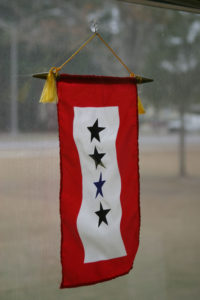
Mark Hutson’s mission at Service Flag Tradition is to educate Americans about this long-established, but nearly forgotten, home front tradition and to share the stories of veterans and their families.
Service Flag Tradition’s motto is, “For every star, there’s a story.” The Girl Who Wore Freedom team also believes in the power of a story. It can be used to honor and remember the men and women that sacrifice and serve. Therefore, as part of our Arlington Heights event on February 6th, we will host a special presentation of service flags to three Gold and Blue Star families beginning at 7:45 pm.
What is a Service Flag?
At the height of WWII, approximately 11% of the U.S. population was actively serving in the U.S. Armed Forces. During the war, it was quite common to find service flags everywhere: homes, churches, towns, stores, and more. In the 1940s, the American people were striving together to fight the aggression of the Axis powers in any way they could: planting victory gardens, buying war bonds, and flying their service flags. These were all tangible things U.S. citizens could do to demonstrate their support for the war and their loved ones fighting it. However, after WWII, the use of the service flag dropped dramatically. Here at The Girl Who Wore Freedom, we think it’s high time to shine a spotlight on this tradition.
Mark Hutson, thank you for everything you’re doing to keep this tradition alive and for sharing this history lesson of the service flag so that we can share it with others.
Please read on to learn more…
History of the Blue Star
The Service Flag (the Blue Star Banner or Son in Service Flag) is an official banner authorized by the Department of Defense for families who have members serving in the U.S. Armed Forces to display during any war or hostilities. Each blue star on the Service Flag represents a family member in the service during a conflict.
The flag was designed and patented by retired Captain R. L. Queisser of the 5th Ohio Infantry from East Cleveland, OH. The Captain was inspired to create the service flag in honor of his two sons. Lieutenant Charles Queisser and 2nd Lieutenant Robert L. Queisser Jr. would soon serve in World War I. Captain Queisser said he wanted to create a symbol to demonstrate that his sons were away in service to their country. In an excerpt from the editorial page of the San Bernardino Daily Sun, dated February 24th, 1918, Captain Queisser describes how the service flag came about:
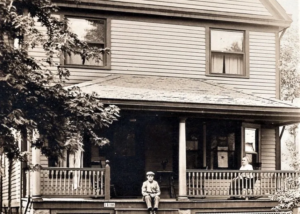
‘My injury occurred on March 15th, 1917 and shortly after April 6th, when war with Germany was declared, (at that time still being confined to the house by my injuries), the thought came to me that both of my sons who were still officers in the guard would again be called out. I wondered if I could not evolve some sign or symbol by which it might be known that they were away in their country’s service and one which would be to their mother a visible sign of the sacrifice her sons were making.”
The flags quickly became a popular symbol. Businesses, churches, and other organizations began flying larger versions to honor their members that were serving. By September 1917, the Congressional Record noted that Ohio had adopted the service flag as a fitting tribute,
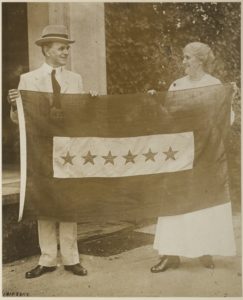
“The world should know of those who give so much for Liberty. The dearest thing in all the world to a father and mother … their children.”
The Gold Star Tradition
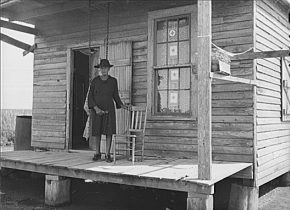
A mother of three soldiers in Plaquemines Parish, Louisiana, displays three gold stars in her window. Photograph by John Vachon, from Library of Congress.
While America’s involvement in WW I was relatively short, March 6th, 1917 to November 11th, 1918, it was very costly. Mothers and widows in mourning wore black dresses and veils. As the country became filled with mourning women, President Woodrow Wilson was concerned that this would have a very negative psychological effect on the public and diminish support for the war.
President Wilson wrote to Dr. Anna Howard Shaw, head of the Women’s Committee of the Council of National Defense, in a letter dated May 16th, 1918. Wilson urged the Council to come up with an alternative way to mourn. The Council recommended wearing a black armband with a gold star sewn in the center for each family member who died during the war. While the President immediately endorsed the idea of the armband, the idea was not embraced by the public. However, this introduced the Gold Star as the symbol of a parent’s ultimate loss. It eventually led to the tradition of covering the Blue Star with a Gold Star for a deceased service member on the Service Flag.
During World War II, the practice of displaying the service flags grew. Images of families and their service flags were used in 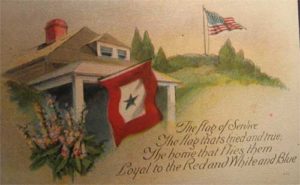 pro-war advertisements.
pro-war advertisements.
Congress passed U.S.C. 179-182 officially authorizing the Service Flag in 1967. The tradition was less popular during the Korean and Vietnam wars but increased in popularity after the attacks of 9/11 and subsequent deployments.
The Girl Who Wore Freedom and Service Flag Tradition wants to encourage everyone with service members in their families to show their stars and spread the word of this noble tradition. If you’d like to order your own service flag, please contact Mark Hutson with Service Flag Tradition.
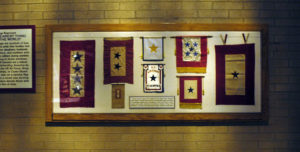
DAYTON, Ohio – The flags are on display in the Kettering Hall at the National Museum of the U.S. Air Force. (U.S. Air Force photo)
Service Flag Facts
- The Service flag may be displayed in a window of the place of residence of persons who are members of the immediate
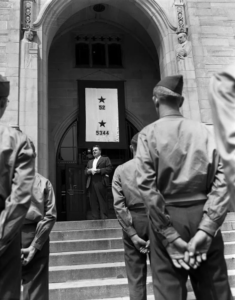 family of Service members serving in the Armed Forces of the United States during any period of war or hostilities in which the Armed Forces of the United States may be engaged.
family of Service members serving in the Armed Forces of the United States during any period of war or hostilities in which the Armed Forces of the United States may be engaged. - Each Blue Star on the flag represents a service member in active duty and can contain up to five stars.
- A Gold Star is displayed if a service member died under honorable conditions.
- The Gold Star is to be placed over the blue star so that the blue star forms a border.
- The colors of the stars are symbolic: The Blue Star represents hope and pride, and the Gold Star represents sacrifice to the cause of liberty and freedom.
- Organizations from which members of the Armed Forces are serving, which include churches, places of business, schools, and colleges, may also display the Service Flag.
- Instead of displaying a separate star for each member, one star may be used with the number of the members indicated by a blue Arabic numeral placed below the star.
- The Service Flag is an indoor flag and should be flown facing out from the front window of the home or organization.
- The Service Flag should be treated with dignity and respect. When displayed with the American Flag, the Service Flag, officially measuring 8.5″ x 14″, shall be of approximately equal size but never larger.
- The Service Flag can be flown vertically or horizontally. When displayed horizontally, the flag will have the star arranged in a horizontal line with one point up.

Recent Comments